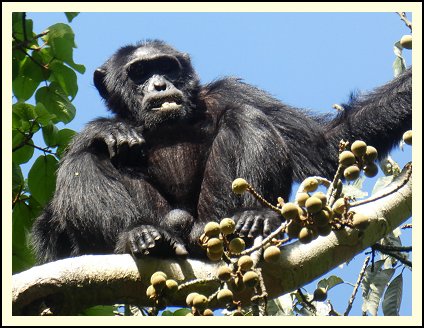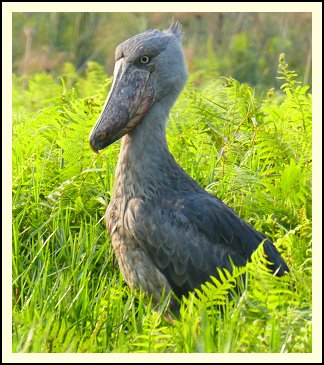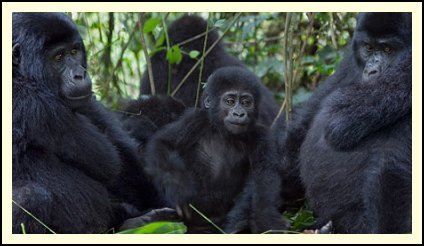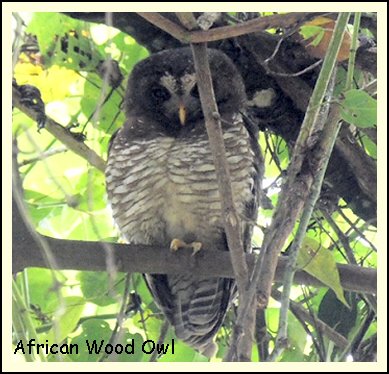
24th January to 4th February 2020 ............ Dave and Isobel Butterworth's trip to Uganda.
Arrival 24th January 25C - sunny
A typical international flight arrives at Entebbe airport on the shores of the sea like Lake Victoria.
Entebbe is a fairly relaxed place to stay a couple of days and about an hour down the highway from the very busy inland capital of Kampala. Most older people will remember the hostage taking at Entebbe, but this portion of the airport is now a large UN flight base serving operations into South Sudan and Western Congo, location of the mountain gorillas and bordering Bwindi impenetrable forest in Uganda.
Our hotel, the "Two friends" borders onto lake Victoria and a fishing boat bobs with a grey heron, long-tailed cormorant and a couple of pied kingfishers on board. A Nile monitor casually swims by.
A walk into the Entebbe botanical gardens and beach area reveals the following :
Vervet monkey, guereza colobus monkey, cattle and little egret, black-headed heron, hamerkop
Marabou stork, hadada ibis, yellow-billed duck, black kite, African harrier hawk, palm nut vulture, African fish eagle, black winged stilt , red eyed dove ,common sandpiper, great blue turaco, Ross's turaco, Eastern plantain eater, African cuckoo, European bee eater, blue cheeked bee eater, broad-billed roller, crowned hornbill, African pied hornbill, barn swallow, African pied wagtail, Western yellow wagtail, common bulbul , red-chested sunbird, slender and yellow-backed weaver and black and white casqued hornbill.
A number of the above mammals and birds were seen on consecutive days, so for the sake of avoiding boring you to death I will only mention new species seen on subsequent days!
25th January 25C - sunny
A key day today, involving driving an hour and a half on tracks around to the Mabamba wetlands where powered dug out boats are taken to see the shoebill. In this pristine undeveloped area, actually only a short distance from Entebbe, we are lucky and see both a mature and younger bird at close range. Many varieties of birds are seen here and on the following journey to Lake Mburo.
New species: Olive baboon, striped ground squirrel, burchells zebra, defassa waterbuck,
shoebill, squacco heron, sacred ibis, Egyptian goose, black-shouldered kite, African marsh harrier, Ovambo sparrow hawk, lizard buzzard, long-crested eagle ,crested francolin, helmeted guineafowl, black crake, grey-crowned crane, African jacana ,water thick knee, long-toed lapwing, common greenshank, wood sandpiper, speckled pigeon, ring necked dove, bare-faced go-away-bird, little swift, speckled mousebird, malachite and African Pygmy kingfisher, blue-breasted bee eater, African thrush, swamp flycatcher, winding cisticola, papyrus gonolek, Ruppells long-tailed starling, village weaver, red-billed firefinch, red-cheeked cordon bleu (this is one beautiful bird, seen on a couple of days in sorghum fields) and a green-winged pytiria.
26th January 20C
A day at Lake Mburo is accessed via a grassed bank which is trimmed by kneeling warthogs. The large lake has natural papyrus banks which are the home to alternating malachite and pied kingfishers, the area behind is still the preserve of black and green mambas. yellow-billed duck, black kite, African harrier hawk, palm nut vulture, African fish eagle, black winged stilt , red eyed dove ,common sandpiper, great blue turaco, Ross's turaco, Eastern plantain eater, African cuckoo, European bee eater, blue cheeked bee eater, broad-billed roller, crowned hornbill, African pied hornbill, barn swallow, African pied wagtail, Western yellow wagtail, common bulbul , red-chested sunbird, slender and yellow-backed weaver and black and white casqued hornbill.
A number of the above mammals and birds were seen on consecutive days, so for the sake of avoiding boring you to death I will only mention new species seen on subsequent days!
25th January 25C - sunny
A key day today, involving driving an hour and a half on tracks around to the Mabamba wetlands where powered dug out boats are taken to see the shoebill. In this pristine undeveloped area, actually only a short distance from Entebbe, we are lucky and see both a mature and younger bird at close range. Many varieties of birds are seen here and on the following journey to Lake Mburo.
New species: Olive baboon, striped ground squirrel, burchells zebra, defassa waterbuck,
shoebill, squacco heron, sacred ibis, Egyptian goose, black-shouldered kite, African marsh harrier, Ovambo sparrow hawk, lizard buzzard, long-crested eagle ,crested francolin, helmeted guineafowl, black crake, grey-crowned crane, African jacana ,water thick knee, long-toed lapwing, common greenshank, wood sandpiper, speckled pigeon, ring necked dove, bare-faced go-away-bird, little swift, speckled mousebird, malachite and African Pygmy kingfisher, blue-breasted bee eater, African thrush, swamp flycatcher, winding cisticola, papyrus gonolek, Ruppells long-tailed starling, village weaver, red-billed firefinch, red-cheeked cordon bleu (this is one beautiful bird, seen on a couple of days in sorghum fields) and a green-winged pytiria.
26th January 20C
A day at Lake Mburo is accessed via a grassed bank which is trimmed by kneeling warthogs. The large lake has natural papyrus banks which are the home to alternating malachite and pied kingfishers, the area behind is still the preserve of black and green mambas. In trees to the rear fish eagles are found all around the lake. Our boatman buzzes his small fibreglass craft towards the groups of hippos which look on then disappear below the surface. Lines of bubbles surface as the hippos pass alongside the boat then resurface on the other side
One hippo charges us but dips under the water as he gets close. Phew. We find the lake rarity, the African finfoot
The Mburo parkland has no mammal predators so wildlife is relaxed and inquisitive.
New species: Hippopotamus, warthog, Rothschilds giraffe, African buffalo, Bushbuck,
Eland, Impala, Topi, dwarf mongoose and Nile crocodile.
Little grebe, African white-backed and lappet-faced vultures, brown snake eagle, bataleur ( short-tailed eagle), Wahlbergs eagle, red-necked francolin, African finfoot, three-banded plover, wattled lapwing, african green pigeon, blue-spotted wood dove, brown parrot, red-headed love bird, levaillants cuckoo, grey-headed kingfisher, woodland kingfisher, striped kingfisher, European bee eater, little bee eater, lilac-breasted roller, green wood hoopoe, African grey hornbill, spot-flanked barbet, crested barbet, Nubian woodpecker, arrow marked babbler, sooty chat, trilling cisticola, tropical boubou, black-headed gonolek, yellow-billed oxpecker, baglafecht weaver, lesser masked weaver, yellow-fronted canary.
27th January 25c - sunny
Today is a transit day from Lake Mburo to the Bwindi Impenetrable forest in the south west of Uganda on the Congo border. Wild seeds, sorghum and abundant insect life attract some exceptionally colourful birds such as the red bishop and paradise flycatcher.
New species: Pink-backed pelican, woolly-necked stork, banded snake eagle, augur buzzard, dideric cuckoo, white-browed coucal, cinnamon-chested bee eater, double-toothed barbet, white-headed saw-wing, plain-backed pipit, white-browed robin chat, common stonechat, African moustached warbler, African blue flycatcher, African paradise flycatcher, common fiscal, Mackinnons fiscal, grey-backed fiscal, pied crow, collared sunbird, copper sunbird, grey-headed sparrow, southern red bishop, fan-tailed widow bird, bronze manikin.
28th January 23 - cloudy
In trees to the rear fish eagles are found all around the lake. Our boatman buzzes his small fibreglass craft towards the groups of hippos which look on then disappear below the surface. Lines of bubbles surface as the hippos pass alongside the boat then resurface on the other side
One hippo charges us but dips under the water as he gets close. Phew. We find the lake rarity, the African finfoot
The Mburo parkland has no mammal predators so wildlife is relaxed and inquisitive.
New species: Hippopotamus, warthog, Rothschilds giraffe, African buffalo, Bushbuck,
Eland, Impala, Topi, dwarf mongoose and Nile crocodile.
Little grebe, African white-backed and lappet-faced vultures, brown snake eagle, bataleur ( short-tailed eagle), Wahlbergs eagle, red-necked francolin, African finfoot, three-banded plover, wattled lapwing, african green pigeon, blue-spotted wood dove, brown parrot, red-headed love bird, levaillants cuckoo, grey-headed kingfisher, woodland kingfisher, striped kingfisher, European bee eater, little bee eater, lilac-breasted roller, green wood hoopoe, African grey hornbill, spot-flanked barbet, crested barbet, Nubian woodpecker, arrow marked babbler, sooty chat, trilling cisticola, tropical boubou, black-headed gonolek, yellow-billed oxpecker, baglafecht weaver, lesser masked weaver, yellow-fronted canary.
27th January 25c - sunny
Today is a transit day from Lake Mburo to the Bwindi Impenetrable forest in the south west of Uganda on the Congo border. Wild seeds, sorghum and abundant insect life attract some exceptionally colourful birds such as the red bishop and paradise flycatcher.
New species: Pink-backed pelican, woolly-necked stork, banded snake eagle, augur buzzard, dideric cuckoo, white-browed coucal, cinnamon-chested bee eater, double-toothed barbet, white-headed saw-wing, plain-backed pipit, white-browed robin chat, common stonechat, African moustached warbler, African blue flycatcher, African paradise flycatcher, common fiscal, Mackinnons fiscal, grey-backed fiscal, pied crow, collared sunbird, copper sunbird, grey-headed sparrow, southern red bishop, fan-tailed widow bird, bronze manikin.
28th January 23 - cloudy
 Today is the amazing trek in the Bwindi forest to see the mountain gorillas. In our case this is a two hour 45 degree eight hundred foot vertical climb, followed by a 20 minute machete cut route through the plateau bush to eight strong gorilla family a few miles from the Congo border. The hour long visit with the areas largest silverback, females and young is relaxed and eye to eye contact with the gorillas is no problem. The photography is wonderful.
New species: Mountain gorilla
Today is the amazing trek in the Bwindi forest to see the mountain gorillas. In our case this is a two hour 45 degree eight hundred foot vertical climb, followed by a 20 minute machete cut route through the plateau bush to eight strong gorilla family a few miles from the Congo border. The hour long visit with the areas largest silverback, females and young is relaxed and eye to eye contact with the gorillas is no problem. The photography is wonderful.
New species: Mountain gorilla
29th January 20 - cool
Today there is a walk around the lower lying forest area where there is great habitat diversity
The Batwa hunter gatherer people known previously as Pygmy, have moved from the higher area where the gorillas reside and now have their own agricultural land and facilities including a hospital close to the village.
New species: Blue monkey, Boehms squirrel,Tambourine dove, red-chested cuckoo, African wood owl, grey-throated barbet, yellow-rumped tinkerbird, Angola swallow, lesser striped swallow, Cape wagtail, Cameroon sombre greenbul, little greenbul, toro olive greenbul, honeyguide greenbul, grey-winged robin, snowy-crowned robin- chat , African dusky flycatcher, dusky blue flycatcher, white-eyed slaty flycatcher, grey-throated flycatcher, chubbs cisticola, white-chinned prinia, grey-backed cameroptera, buff-throated apalis, grey apalis, white tailed blue flycatcher, black and white flycatcher, brown throated wattle eye, bocages bush shrike, Leudhers bush shrike, pink-footed puff back, Petits bush shrike, green sunbird, green-headed sunbird, green-throated sunbird, variable sunbird, northern double collared sunbird, bronze sunbird, black-necked weaver, viellots black weaver, brown-capped weaver, white-breasted nigrita, thick-billed seedeater, golden breasted bunting, grey capped warbler, great sparrowhawk , yellow white eye.
30th January 18-20C - wet cool cloudy
Transit from Bwindi to Queen Elizabeth National park
This was a great day for birding with the red, yellow and black bishop all seen in one day. Unfortunately the poor weather meant the tree climbing lions were not on view.
New species: African elephant, Ugandan kob, chameleon
Martial eagle, white-throated bee-eater, red-throated wryneck, yellow-throated longclaw, red-billed quelea, black bishop, yellow bishop, red-headed bluebill, common waxbill, pin-tailed whydah.
31st January 20C cool and wet
Tour of Queen Elizabeth national park savannah and boat journey along the Kazinga channel between Lake Edward and Lake George close to the Congo border. The channel is home to hippo, crocodile and many shoreline birds. The savannah has abundant wildlife but is short on predators and variety. Cattle farming lies just outside the park.
New species: Banded mongoose , lion and forest elephant.
Great cormorant, great egret, yellow-billed stork, African spoonbill, black-breasted snake eagle, pallid harrier, Eurasian marsh harrier, grey kestrel, Temmincks courser, ringed plover, Kittlitz's plover, spur-winged Senegal, and crowned lapwing, little stint, black-tailed godwit, ruddy turnstone, lesser black-backed gull, gull-billed tern, African skimmer, rufous naped lark, whinchat, zitting cisticola, African hoopoe, piapiac
1st February 23C - fair
The next day was spent touring the scenic volcanic cratered area next to the park
New species:
Common kestrel, African crake, blue naped mousebird, flappet lark, African pipit, black crowned tchagra, scarlet chested sunbird,
2nd February 23 - fair
Transfer to Kibali national park home to chimpanzees and a number of other primates. We luckily saw three lions resting in the long grass on route. The approach to the area is at altitude with tea and coffee plantations and more volcanic geology.
New species:
Laughing dove, speckled tinkerbird, yellow-spotted barbet, red-capped robin-chat.
3rd February - 20C fair with later tropical storm
A great morning viewing large numbers of chimps feasting on figs 70 feet up in the canopy
Disputes between chimps creates extremely loud aggressive vocalisation. The impending storm meant chimps did not descend from the trees where they make a new individual nest each day.
Rangers carry weapons to ward off contact from unruly forest elephants. The afternoon is spent in the adjacent swampland looking for monkey species that avoid the chimpanzees.
New species: Chimpanzee, red-tailed monkey, Ugandan red colobus ( primary prey species for chimpanzees).
Purple-headed starling
4th February - 22C fair
A group of spectacular group of white-headed hoopoe are seen on the return to Entebbe reside and now have their own agricultural land and facilities including a hospital close to the village.
New species: Blue monkey, Boehms squirrel,Tambourine dove, red-chested cuckoo, African wood owl, grey-throated barbet, yellow-rumped tinkerbird, Angola swallow, lesser striped swallow, Cape wagtail, Cameroon sombre greenbul, little greenbul, toro olive greenbul, honeyguide greenbul, grey-winged robin, snowy-crowned robin- chat , African dusky flycatcher, dusky blue flycatcher, white-eyed slaty flycatcher, grey-throated flycatcher, chubbs cisticola, white-chinned prinia, grey-backed cameroptera, buff-throated apalis, grey apalis, white tailed blue flycatcher, black and white flycatcher, brown throated wattle eye, bocages bush shrike, Leudhers bush shrike, pink-footed puff back, Petits bush shrike, green sunbird, green-headed sunbird, green-throated sunbird, variable sunbird, northern double collared sunbird, bronze sunbird, black-necked weaver, viellots black weaver, brown-capped weaver, white-breasted nigrita, thick-billed seedeater, golden breasted bunting, grey capped warbler, great sparrowhawk , yellow white eye.
30th January 18-20C - wet cool cloudy
Transit from Bwindi to Queen Elizabeth National park
This was a great day for birding with the red, yellow and black bishop all seen in one day. Unfortunately the poor weather meant the tree climbing lions were not on view.
New species: African elephant, Ugandan kob, chameleon
Martial eagle, white-throated bee-eater, red-throated wryneck, yellow-throated longclaw, red-billed quelea, black bishop, yellow bishop, red-headed bluebill, common waxbill, pin-tailed whydah.
31st January 20C cool and wet
Tour of Queen Elizabeth national park savannah and boat journey along the Kazinga channel between Lake Edward and Lake George close to the Congo border. The channel is home to hippo, crocodile and many shoreline birds. The savannah has abundant wildlife but is short on predators and variety. Cattle farming lies just outside the park.
New species: Banded mongoose , lion and forest elephant.
Great cormorant, great egret, yellow-billed stork, African spoonbill, black-breasted snake eagle, pallid harrier, Eurasian marsh harrier, grey kestrel, Temmincks courser, ringed plover, Kittlitz's plover, spur-winged Senegal, and crowned lapwing, little stint, black-tailed godwit, ruddy turnstone, lesser black-backed gull, gull-billed tern, African skimmer, rufous naped lark, whinchat, zitting cisticola, African hoopoe, piapiac
1st February 23C - fair
The next day was spent touring the scenic volcanic cratered area next to the park
New species:
Common kestrel, African crake, blue naped mousebird, flappet lark, African pipit, black crowned tchagra, scarlet chested sunbird,
2nd February 23 - fair
Transfer to Kibali national park home to chimpanzees and a number of other primates. We luckily saw three lions resting in the long grass on route. The approach to the area is at altitude with tea and coffee plantations and more volcanic geology.
New species:
Laughing dove, speckled tinkerbird, yellow-spotted barbet, red-capped robin-chat.
3rd February - 20C fair with later tropical storm
A great morning viewing large numbers of chimps feasting on figs 70 feet up in the canopy
Disputes between chimps creates extremely loud aggressive vocalisation. The impending storm meant chimps did not descend from the trees where they make a new individual nest each day.
Rangers carry weapons to ward off contact from unruly forest elephants. The afternoon is spent in the adjacent swampland looking for monkey species that avoid the chimpanzees.
New species: Chimpanzee, red-tailed monkey, Ugandan red colobus ( primary prey species for chimpanzees).
Purple-headed starling
4th February - 22C fair
A group of spectacular group of white-headed hoopoe are seen on the return to Entebbe
With so many mammals and over two hundred and ten species of birds, this is a superb option for anyone thinking of a tour to East Africa.
Dave Butterworth
African Thick Knee and Blue Agama Lizzard
Fan-tailed Widow Bird and Finfoot
Fish Eagle and Malachite Kingfisher
Ugandan Grey-crowned Crane and Wattled Lapwing
Food distribution and a Ugandan water heater!
|